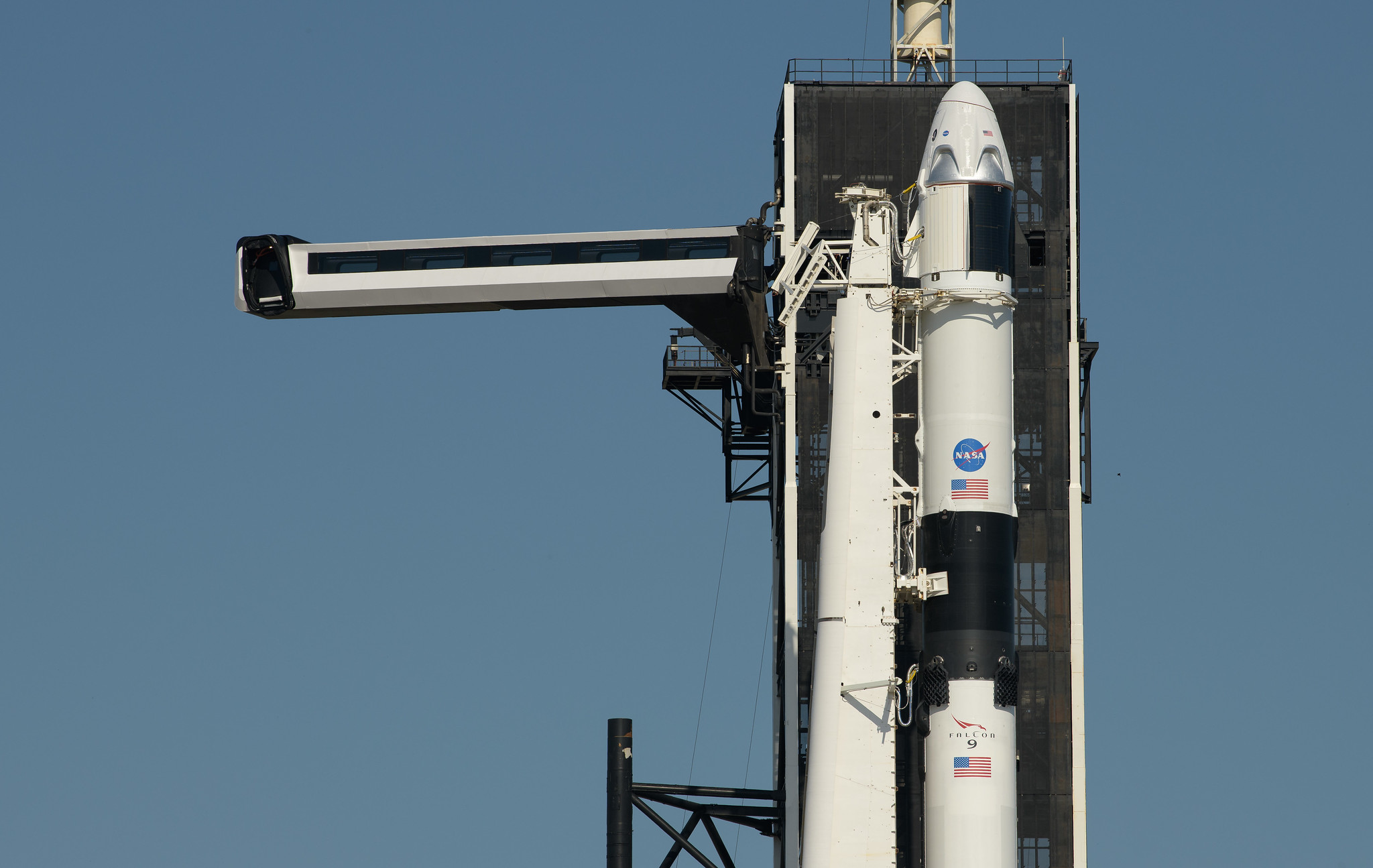SpaceX is poised to make history today (May 27).
The company's first-ever crewed mission, a test flight called Demo-2, is scheduled to launch at 4:33 p.m. EDT (2033 GMT) from NASA's Kennedy Space Center in Florida.
You can watch the liftoff — the first crewed orbital launch from the United States since NASA grounded its space shuttle fleet in 2011 — live here and on the Space.com homepage, courtesy of NASA, or directly via the space agency.
"We are once again launching American astronauts on American rockets from American soil," NASA Administrator Jim Bridenstine said during a news conference yesterday (May 26). "This is a big moment in time. It's been nine years since we've had this opportunity."
Related: How SpaceX's Crew Dragon Demo-2 mission will work in 13 steps
Weather in Florida is a bit of a concern. There's a 40% chance that clouds and foul weather will keep SpaceX on the ground. If that happens, NASA and SpaceX will have to wait until Saturday (May 30) to try again.
Demo-2 will send NASA astronauts Bob Behnken and Doug Hurley to the International Space Station (ISS). The mission is designed to fully validate SpaceX's Crew Dragon capsule and Falcon 9 rocket for human spaceflight, so the company can begin flying operational crewed missions for NASA.
Get the world’s most fascinating discoveries delivered straight to your inbox.
SpaceX signed a $2.6 billion contract with NASA in 2014 to complete six such missions, the first of which will lift off shortly after Demo-2 lands, provided all goes well with the test flight. NASA inked a similar, $4.2 billion deal at the same time with Boeing, which the aerospace giant will fulfill using its CST-100 Starliner capsule.
NASA wants these private vehicles to end American dependence on Russian Soyuz spacecraft, which have been astronauts' only ride to and from orbit since the shuttles were grounded. And Demo-2 brings that goal within reach at long last.
Today's liftoff will also mark the first crewed debut of an American orbital spacecraft since April 1981, when the shuttle flew its initial space mission. And Crew Dragon will be just the fifth U.S. vehicle, and the ninth overall, to carry astronauts to Earth orbit or beyond.
So, yeah: Demo-2 is a pretty big deal. President Donald Trump is even going to attend.
Related: Here's every spaceship that's ever carried an astronaut into orbit
After launching today, Crew Dragon will spend 19 hours chasing the space station down. The capsule is scheduled to dock with the orbiting lab tomorrow (May 28) at 11:39 a.m. EDT (1539 GMT), and the hatches between the two craft will open about 2.5 hours later.
Behnken and Hurley will then float aboard the space station, kicking off a stay of unknown duration. Demo-2 will last between 30 days and four months, NASA officials have said; the end date will be determined later, after mission team members have had a chance to assess Crew Dragon's performance and the readiness of the capsule that will fly Crew-1, SpaceX's first operational human spaceflight mission.
Starliner isn't ready to fly astronauts yet, by the way. The Boeing capsule failed to meet up with the ISS as planned during its uncrewed Orbital Flight Test (OFT) in December 2019. (SpaceX successfully completed its version of this mission, called Demo-1, in March of last year.) Starliner will refly OFT before welcoming crewmembers aboard, and it's unclear at the moment when that makeup mission will launch.
And a quick note about milestones: Today's launch will not be the first human spaceflight of any sort to launch from the U.S. since the shuttles' retirement.
The space tourism company Virgin Galactic has launched two piloted test flights to suborbital space from California with its VSS Unity spaceliner, once in December 2018 and again in February 2019. VSS Unity is a suborbital vehicle, so it's not designed to make any loops around Earth.
Visit Space.com for complete coverage of SpaceX's Crew Dragon Demo-2 flight.
- Meet the NASA astronauts launching on SpaceX's historic Crew Dragon test flight
- Here's what SpaceX's 1st spaceship to carry astronauts looks like from space (satellite photos)
- SpaceX's Crew Dragon Demo-1 test flight in pictures
Mike Wall is the author of "Out There" (Grand Central Publishing, 2018; illustrated by Karl Tate), a book about the search for alien life. Follow him on Twitter @michaeldwall. Follow us on Twitter @Spacedotcom or Facebook.
OFFER: Save 45% on 'All About Space' 'How it Works' and 'All About History'!
For a limited time, you can take out a digital subscription to any of our best-selling science magazines for just $2.38 per month, or 45% off the standard price for the first three months.






